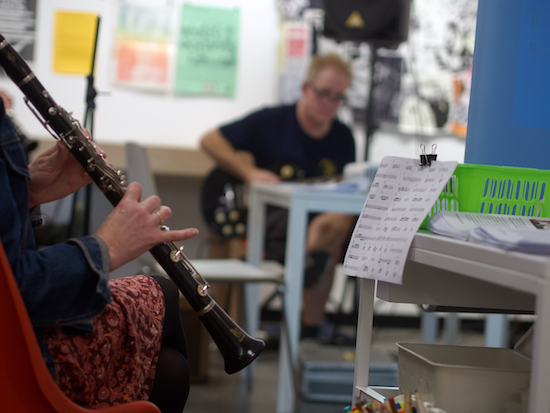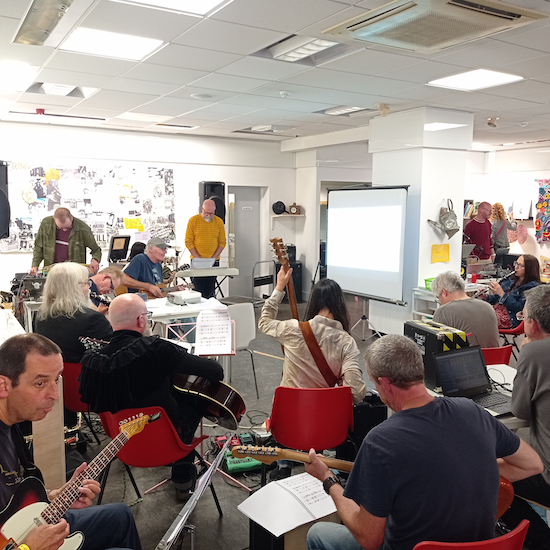To receive In C by Farmer Glitch, Matthew Saunders & Friends become a Quietus Sound & Vision subscriber
In C’s new 51 minute recording, the latest entry in the Quietus’ Sound & Vision series of releases available exclusively to tQ subscribers, is both a testament to decades spent in the improvising trenches and an invitation for the callow first-timer to join the fray. It’s a piece of sound art that, while thriving on autonomy, has been made to happen by the communal zeal of two participants above all. Oh, and it’s as much of a blast to listen to as it sounds like it was to play. In these respects, it’s a typical rendition of Terry Riley’s In C: a piece which, in its conceptual genius, is essentially guaranteed to be atypical every time it’s played.
“We don’t know any other piece which is so inclusive,” says Farmer Glitch – aka Stephen Ives, a musician and equipment builder from south west England. “That’s what it’s about, for us – making a piece which is fun to play without being too intellectually or technically challenging. People enjoy doing it and it sounds great. We work with musicians and non-musicians – get the kids involved, open it up to everyone.”
“People are intrigued by it,” continues Matthew J. Saunders, who with Ives was the prime logistical mover behind this take on Riley’s magnum opus. “It’s non-hierarchical, and anyone can join in with it, but when it gets going, you can really get into a groove.”
The ensemble tackling In C here includes 11 musicians, plus Ives (guitar) and Saunders (modular synth), whose performance took place in September 2023 at the Yeovil Art Space. It formed part of Wyrd Wild West, a day of “sound interventions” and general avant-garde shenanigans across Yeovil town centre. If you’re surprised to read of such things going on in this unassuming Somerset burg, you’re not alone, but WWW – primarily Saunders’ brainchild – taps into a longer history of DIY and counterculture art in the area. It’s linked to an ongoing archive project, href="https://yeovilartspace.uk/storyofyeovil/" target="out">Story Of Yeovil, which currently includes an exhibition of early punk/anarcho zines from people like Mark Wilson of The Mob (probably the most widely influential band to come from the town). Ives’ agrarian pseudonym, meanwhile, comes from his early 2010s ‘make do and mend’ electronic trio Hacker Farm, who operated out of a local nursery garden.
“We’re in the middle of the high street, more or less, the main shopping area,” Ives explains; he and Saunders are speaking to me in the Eastville Project Space, which Ives set up in 2021 and which is adjacent to the Yeovil Art Space. “The doors are wide open and people wandering around town are thinking, ‘What’s that?’ People who wouldn’t normally be exposed to some minimalist composition from the 60s. And it’s actually sounding fantastic, and people are really liking it.”
Saunders – who moved to Somerset in the late 00s from Birmingham, where he’d played in Magnétophone – sees this space as being in the direct lineage of the San Francisco Tape Music Center, where In C was first performed in 1964 by an ensemble that included Riley, Pauline Oliveros, Steve Reich and Morton Subotnick. “What a fantastic period in the history of arts and music, and we can have a little bit of that. We can bring it to Yeovil of all places!”
Wyrd Wild West was the third Farmer Glitch-helmed public performance of In C to date: the previous two were in 2021 and 2023, both at a Wiltshire micro-festival named Acid Horse and co-organised by tQ’s John Doran. (The previous entry in the Sound & Vision series, by M.L. Deathman, is a live recording from the 2023 edition.) “The Acid Horse ones started off with a sort of workshop,” Ives says. “This one was a bit more performative. A number of people worked on [their parts] in advance. Saying that, a lot of people who turned up we’d never met before.”
Others on the recording were very much known entities, including peddler of crepuscular Cornish electronica Kemper Norton; Nigel Ayers, best known for the long-running proto-industrial project Nocturnal Emissions; and Neil Mortimer of Urthona and Luminous Foundation. All those participants played post-In C sets later that day, as did Saunders under his Twilight Sequence pseudonym.

In C is constructed from 53 distinct musical phrases, or patterns, as indicated on its score. The phrases – a lot of which, Saunders notes, “are great riffs” – can be played over and over, for as long as any given musician feels like, although the objective (as per Riley’s original directions) is that “performers should stay within two or three patterns of each other”.
In Yeovil, recalls Saunders, “We had a number of really competent players, weaving in and out of the phrases. There are particular phrases, like number 35, which is difficult. It’s the one everyone fears! It’s long, there are long gaps, and it’s bizarre. It’s a pivotal point in the performance because it feels like it could fall apart. This one was really enjoyable, people playing on either side of the modular synth.”
Listening to the recording – done by two attendees with a room mic apiece, unbeknownst to the organisers until later – the peaks and troughs, and its general tectonic development, make for a fine scenic journey. Two sections, around 20 and 43 minutes respectively, display a notable downturn in instrumental intensity. “I suspect the one after 20 minutes will have fallen naturally,” Saunders says; “that’s quite a long time [to play continuously]. I think people collectively take a breather.
“The 43-minute one, we’re getting towards the end of the performance, when we really build it up and it gets quite slamming. So I change the tone of the actual C note – the metronome – and quieten everything down. And everyone follows. We can generate these points just by a feeling.”
Ives recalls playing the recording back with his wife recently: “She was just like, ‘how do you all know where you’re going?’ We don’t! But you’re listening. If we sat down with the same people and did it again, it wouldn’t be that – it would be different. And yet it does come together.”
To receive In C by Farmer Glitch, Matthew Saunders & Friends, as well as a host of other benefits including exclusive essays, podcasts and playlists, and loads more specially-commissioned music, become a Quietus Sound & Vision subscriber. You can do so here



